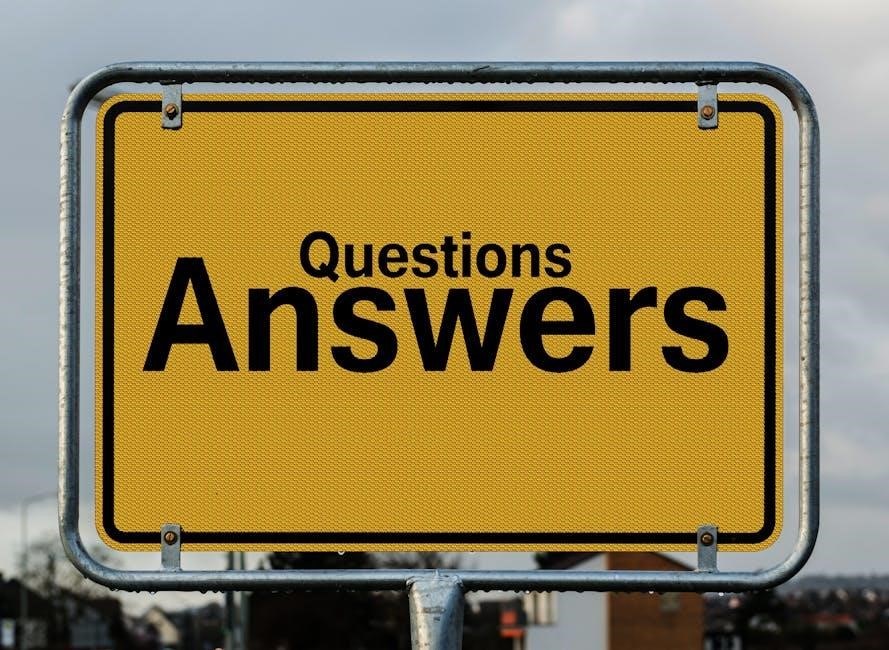Sacramento offers a diverse TV market with major networks like ABC, CBS, NBC, and FOX, ensuring access to news, sports, and entertainment for its vibrant community.
Local channels provide essential updates, reflecting the city’s cultural and social fabric, making them indispensable for residents seeking reliable information and connectivity.
1.1 Overview of Sacramento’s TV Market
Sacramento’s TV market is dynamic, offering a mix of major network affiliates, local programming, and niche channels. Residents can access ABC, CBS, NBC, and FOX affiliates, ensuring diverse content.
- ABC 10 provides breaking news and weather updates.
- CBS 13 focuses on local stories and investigative journalism.
- NBC 3 offers a blend of news, sports, and entertainment.
- FOX 40 covers trending topics and community events.
This variety caters to Sacramento’s diverse population, delivering both national and local content seamlessly.
1.2 Importance of Local Channels for Residents
Local channels are vital for Sacramento residents, providing hyper-local news, weather, and community updates. They cover city-specific events, politics, and cultural activities, keeping residents informed about issues that directly impact their lives. Local channels also offer emergency alerts, ensuring public safety during crises. Additionally, they foster community engagement by highlighting local businesses, schools, and events, making them indispensable for staying connected to the region’s pulse.

Major Network Affiliates in Sacramento
Sacramento’s major network affiliates include ABC, CBS, NBC, and FOX, providing essential local and national news, entertainment, and sports programming. These channels cater to the diverse needs of the community, ensuring residents stay informed and engaged with both local and national events.
2.1 ABC Affiliates (e.g., ABC 10)
ABC 10, an ABC affiliate, serves Sacramento with a mix of local news, weather, and ABC network programming. It offers breaking news, investigative reports, and community-focused stories. Known for its comprehensive coverage of Sacramento events, ABC 10 provides updates on local politics, education, and cultural activities. The channel also airs popular ABC shows like “Good Morning America” and “World News Tonight.” With a strong commitment to community engagement, ABC 10 ensures residents stay informed and connected to their city.
2.2 CBS Affiliates (e.g., CBS 13)
CBS 13 is a prominent CBS affiliate serving Sacramento, offering a blend of local news, weather, and CBS network programming. Known for its in-depth coverage of regional issues, CBS 13 provides updates on Sacramento’s political landscape, crime reports, and community events. The channel airs popular CBS shows like “CBS Evening News” and “60 Minutes.” With a strong focus on investigative journalism, CBS 13 ensures viewers stay informed about local and national developments, making it a trusted source for news and entertainment in the Sacramento area.
2.3 NBC Affiliates (e.g., NBC 3)
NBC 3, also known as KCRA-TV, is a leading NBC affiliate in Sacramento, providing a mix of local news, weather, and NBC network programming. The channel is known for its extensive coverage of local news, including updates on crime, politics, and community events. NBC 3 also airs popular NBC shows such as “The Tonight Show,” “Today,” and sports events like “Sunday Night Football.” With a focus on breaking news and community-focused reporting, NBC 3 is a trusted source for Sacramento residents seeking accurate and timely information.
2.4 FOX Affiliates (e.g., FOX 40)
FOX 40 is a prominent FOX affiliate serving the Sacramento area, offering a diverse range of programming. It features local news, weather updates, and sports coverage tailored to the community. Additionally, FOX 40 broadcasts popular network shows such as ‘The Simpsons’ and ‘American Idol,’ making it a versatile choice for viewers. The channel also provides exclusive sports content, including live games and events, catering to sports enthusiasts. With its balanced mix of local and national programming, FOX 40 remains a favorite among Sacramento residents.

Local Programming and News Channels
Sacramento’s local programming and news channels provide essential updates, fostering community engagement and offering diverse content tailored to local interests and preferences.
3.1 KCRA News 3
KCRA News 3 is a leading NBC affiliate serving Sacramento and surrounding areas. Known for its commitment to quality journalism, it provides comprehensive coverage of local news, weather, and sports. The channel offers breaking news updates, investigative reports, and community-focused stories. Viewers rely on KCRA for detailed coverage of events impacting the region. Its team of experienced journalists ensures accurate and timely reporting, making it a trusted source for Sacramento residents. With a strong focus on local issues, KCRA News 3 plays a vital role in keeping the community informed and engaged.
3.2 KXTV-TV (ABC 10)
KXTV-TV, known as ABC 10, is a prominent ABC affiliate in Sacramento. It offers a mix of local news, weather updates, and community-focused programming. ABC 10’s morning show, “ABC10 Morning,” is popular for its engaging format. The channel also airs ABC network shows like “Good Morning America” and “Jimmy Kimmel Live!” ABC 10 is committed to covering local stories, from education to public safety. Its diverse programming ensures entertainment and information for Sacramento viewers, making it a key part of the local TV landscape.
3.3 KOVR-TV (CBS 13)
KOVR-TV, or CBS 13, is Sacramento’s CBS affiliate, offering a wide range of programming. It features local news, weather updates, and CBS network shows like “60 Minutes” and “CBS Evening News.” The station is known for its strong commitment to local storytelling, with a focus on community issues and events. CBS 13’s news team provides in-depth coverage of Sacramento’s neighborhoods, making it a trusted source for area residents. Its diverse lineup ensures a mix of entertainment and information tailored to local viewers.

Sports Channels in Sacramento
Sacramento offers a variety of sports channels, including NBC Sports Bay Area, ESPN, and FOX Sports, covering local and national events, ensuring diverse sports coverage.
4.1 NBC Sports Bay Area
NBC Sports Bay Area is a premier destination for Sacramento sports fans, offering extensive coverage of local teams like the Sacramento Kings and San Francisco Giants. The channel provides live game broadcasts, pre- and post-game analysis, and exclusive interviews. Fans can also enjoy coverage of the Golden State Warriors and 49ers, making it a must-watch for football and basketball enthusiasts. With shows like Giants Pregame Live and Kings Postgame Live, viewers get in-depth insights into their favorite teams’ performances.
4.2 ESPN and ESPN2
ESPN and ESPN2 are essential for Sacramento sports enthusiasts, offering extensive coverage of national and regional events. These channels broadcast live games, including NBA, NFL, MLB, and NHL matchups, as well as college sports. Shows like SportsCenter, Monday Night Football, and Baseball Tonight provide in-depth analysis and updates. Sacramento residents can access ESPN and ESPN2 through cable providers like Xfinity or Spectrum, or via streaming platforms such as Hulu + Live TV and YouTube TV, ensuring uninterrupted access to their favorite sports content.

Entertainment and Lifestyle Channels
Sacramento’s entertainment and lifestyle channels offer diverse programming, including popular shows, movies, and reality TV. Channels like The CW and MyNetworkTV provide engaging content for all audiences.
5.1 The CW (CW 31)
CW 31 is Sacramento’s affiliate for The CW network, offering a mix of popular TV shows, movies, and original programming. Known for series like Riverdale, The Flash, and Supernatural, CW 31 caters to a younger demographic with its dynamic and engaging content. The channel also features reality TV, entertainment news, and lifestyle programs, making it a go-to for viewers seeking diverse and contemporary entertainment options. Its lineup includes both nationally syndicated shows and locally relevant content, ensuring a blend of broader appeal and community-focused programming.
5.2 MyNetworkTV (KQCA 58)
KQCA 58, Sacramento’s MyNetworkTV affiliate, offers a diverse lineup of entertainment programming. The channel airs popular syndicated shows, reality TV series, and encore broadcasts of hit dramas. MyNetworkTV focuses on appealing to a broad audience, particularly younger viewers, with shows like Law & Order: Special Victims Unit and The Good Wife. It also features lifestyle and entertainment programs, making it a versatile option for viewers seeking varied content beyond traditional network offerings. KQCA 58 provides a mix of engaging shows tailored to modern audiences.

Public Access and Community Channels
Sacramento’s public access channels foster community engagement by airing local content, including community events, educational programs, and user-generated content, providing a platform for grassroots programming and diverse voices.
6.1 Access Sacramento
Access Sacramento is a nonprofit public access channel dedicated to community programming. It airs local events, public affairs, and cultural content, fostering civic engagement. Available on Comcast (Channel 17) and AT&T U-verse (Channel 14), it offers diverse programming produced by local residents. The channel also provides training and resources for community members to create their own content. Access Sacramento bridges the gap between local government and residents, ensuring transparency and inclusivity. Its programming reflects the vibrant cultural fabric of Sacramento, making it a valuable resource for community-driven content.
6.2 Sacramento Community Cable Foundation
The Sacramento Community Cable Foundation oversees public, educational, and governmental (PEG) access channels in Sacramento. It manages channels like 17, 18, and 14, available on Comcast and AT&T U-verse. The foundation supports local content creation, airing city council meetings, community events, and cultural programs. It promotes transparency and civic engagement by providing a platform for public discourse. Residents can access these channels to stay informed about local issues and participate in community affairs. The foundation ensures diverse voices are heard, enriching Sacramento’s media landscape.

Educational Channels
Educational channels in Sacramento provide enriching content for learners of all ages; KVIE (PBS) offers documentaries, educational series, and children’s programs, promoting knowledge and skill development. Accessible via OTA antennas or cable providers like Xfinity and Spectrum, these channels are a valuable resource for families and students seeking informative programming.
7.1 PBS (KVIE)
PBS affiliate KVIE is Sacramento’s premier source for educational and cultural programming. It broadcasts a wide range of content, including acclaimed documentaries, educational series, and children’s shows like Sesame Street and Wild Kratts. KVIE serves as a vital resource for students, teachers, and lifelong learners, offering programming that aligns with curriculum standards. The channel also provides access to online educational resources, making it a cornerstone for education in the Sacramento region. Its commitment to quality and learning makes KVIE indispensable for families and educators alike.

How to Access Sacramento Local Channels
Sacramento local channels are accessible via over-the-air antennas, cable providers, and streaming services, ensuring residents can enjoy their favorite shows and stay informed with ease.
8.1 Over-the-Air (OTA) Antenna Options
Over-the-air antennas are a cost-effective way to access Sacramento’s local channels. Indoor antennas like Mohu and Amazon Basics are popular for their ease of use and compact design. Outdoor antennas, such as Winegard models, offer superior range and signal strength. Both options provide free HD broadcasts, making them ideal for budget-conscious viewers. Ensure your antenna is compatible with digital signals for optimal reception of Sacramento’s local stations.
8.2 Cable Providers (e.g., Xfinity, Spectrum)
Cable providers like Xfinity and Spectrum offer comprehensive channel lineups featuring Sacramento’s local stations. Xfinity’s Digital Starter package includes major networks, while Spectrum’s TV Select provides similar coverage. Both services offer HD channels, DVR options, and bundled deals with internet and phone. These providers ensure reliable access to local programming, sports, and news, making them popular choices for Sacramento residents seeking a wide range of entertainment and information options.
8.3 Streaming Services (e.g., Hulu, YouTube TV)
Streaming services like Hulu with Live TV and YouTube TV offer Sacramento residents access to local channels without traditional cable. These platforms include stations like KCRA 3, ABC 10, and CBS 13, ensuring viewers stay updated on local news and sports. Features such as cloud DVR and on-demand content enhance the viewing experience. Both services are available on smartphones, tablets, and smart TVs, providing flexibility and convenience for modern audiences seeking to stream Sacramento’s local channels seamlessly.

Channel Lineup and Numbers
Sacramento’s channel lineup includes major networks like ABC 10, CBS 13, NBC 3, and FOX 40, along with special interest channels such as PBS (KVIE) and sports networks like NBC Sports Bay Area. Viewers can access these channels via OTA antennas, cable providers, or streaming services, ensuring a diverse range of entertainment, news, and educational content tailored to local preferences.
9.1 Major Network Channel Numbers
The major network affiliates in Sacramento include ABC 10, CBS 13, NBC 3, and FOX 40. These channels provide a mix of local news, entertainment, and syndicated programming. ABC 10 airs popular shows like Good Morning America and Dancing with the Stars, while CBS 13 features CBS Mornings and The Late Show with Stephen Colbert. NBC 3 offers Today and The Voice, and FOX 40 includes Fox & Friends and The Simpsons. These channels are accessible via OTA antennas, cable, or streaming services.
9.2 Special Interest Channel Numbers
Sacramento’s special interest channels cater to diverse audiences. PBS (KVIE) on channel 6 offers educational content, while C-SPAN (channel 15) focuses on government and public affairs. Access Sacramento (channel 17) provides community-driven programming, and Sacramento Community Cable Foundation (channel 19) highlights local events. Additionally, channels like C-SPAN2 (channel 16) and C-SPAN3 (channel 14) cover historical and legislative content. These channels are ideal for viewers seeking niche programming beyond mainstream networks.
Sacramento’s local channel guide offers a diverse range of options, ensuring residents can access news, sports, and entertainment tailored to their interests, enhancing their viewing experience.
10.1 Summary of Sacramento’s Local Channels
Sacramento offers a diverse range of local channels, providing residents with access to news, sports, and entertainment. Major network affiliates like ABC, CBS, NBC, and FOX ensure a mix of national and regional programming. Local stations such as KCRA, KXTV-TV, and KOVR-TV deliver targeted news and community-focused content. Additionally, channels like The CW and MyNetworkTV cater to entertainment, while Access Sacramento provides public access programming. This variety ensures that viewers can find content tailored to their interests, making Sacramento’s local channel lineup comprehensive and engaging for all audiences.

10.2 Tips for Maximizing Your Viewing Experience
To enhance your viewing experience in Sacramento, invest in a high-quality OTA antenna for crisp reception. Explore cable and streaming options for expanded channel access. Program your DVR to record favorite shows. Discover hidden gems on community channels like Access Sacramento. Check the TV guide regularly for local events and specials. Adjust your TV settings for optimal picture quality. Mix national networks with local programming for a balanced viewing schedule. Experiment with streaming services for on-demand content. This approach ensures you make the most of Sacramento’s diverse channel offerings.


























































































